We Followed The Tour Signs... All 63 Of Them!
An aircraft carrier is a warship designed with a primary mission of deploying and recovering aircraft, acting as a seagoing airbase. Aircraft carriers thus allow a naval force to project air power great distances without having to depend on local bases for staging aircraft operations. They have evolved from wooden vessels, used to deploy balloons, into nuclear powered warships that carry dozens of fixed and rotary wing aircraft

Did you know? - USS Midway (CVB/CVA/CV-41) was an aircraft carrier of the United States Navy, the lead ship of her class, and the first to be commissioned after the end of World War II. Active in the Vietnam War and in Operation Desert Storm, currently, she is a museum ship in San Diego, California.
She is the only remaining US aircraft carrier of the World War II era that is not an Essex-class ship.
Midway was laid down 27 October 1943 by Newport News Shipbuilding Co., Newport News, Virginia. Her revolutionary hull design was based on what would have been the Montana class battleships and gave her superior maneuverability over all previous carriers. She was launched 20 March 1945; sponsored by Mrs. Bradford William Ripley, Jr.; and commissioned 10 September 1945, Captain Joseph F. Bolger in command.
Did you know? - After shakedown in the Caribbean, Midway joined in the U.S. Atlantic Fleet training schedule, with Norfolk her homeport. From 20 February 1946 she was flagship for CarDiv 1. In March, she tested equipment and techniques for cold weather operations in the North Atlantic. East Coast and Caribbean training was highlighted by Operation Sandy in September 1947, in which she test fired a captured German V-2 rocket from her flight deck, the first such launching from a moving platform.
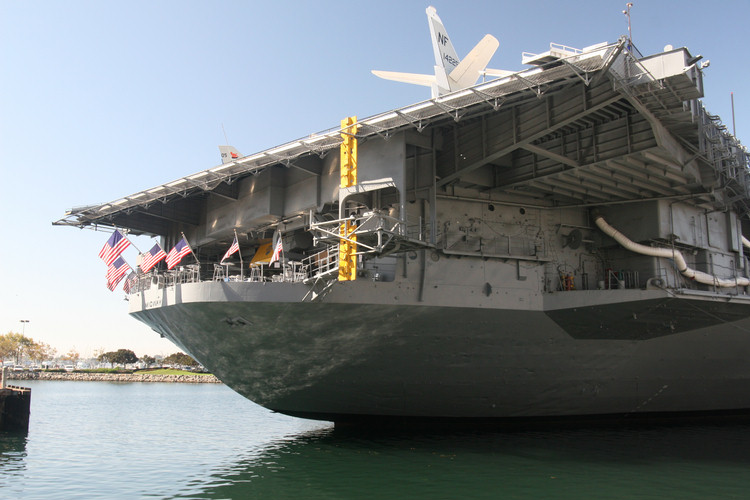
Did you know? - Midway cleared Norfolk 27 December 1954 for a world cruise, sailing via the Cape of Good Hope for Taiwan, where she joined the 7th Fleet for operations in the Western Pacific until 28 June 1955. During these operations, Midway pilots flew cover for the evacuation from the Quemoy-Matsu crisis [1] from the Tachen Islands of 15,000 Chinese nationalist troops and 20,000 Chinese civilians, along with their pigs, cows and chickens. On 28 June 1955 she sailed for overhaul at Puget Sound Naval Shipyard. Here, she was out of commission until 30 September 1957, while she underwent an extensive modernization program (SCB-110). Midway received an enclosed "hurricane bow," an aft deck-edge elevator, an angled flight deck, and steam catapults
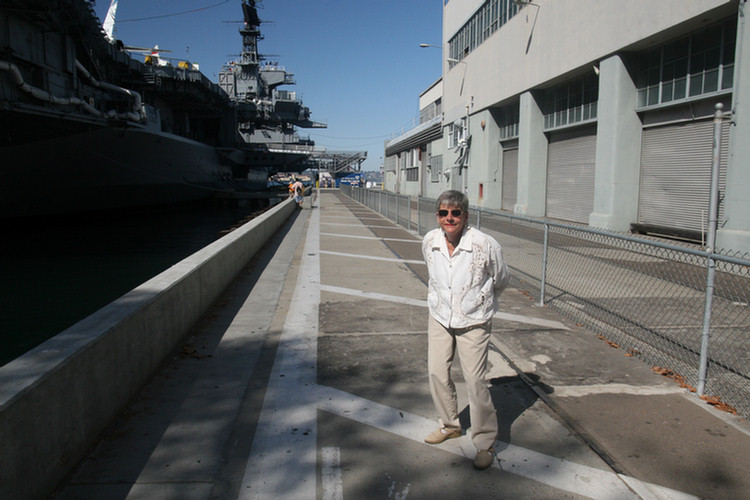

We Made It... And We Bought Our Tickets On-Line

Did you know? - Returning to Alameda on 23 November, Midway entered San Francisco Bay Naval Shipyard on 11 February 1966 for a massive modernization (SCB-101.66) which proved to be very expensive and controversial. The flight deck was enlarged from 2.8 to 4 acres (11,300 to 16,200 m²). The elevators were enlarged, relocated, and given almost double the weight capacity. Midway also received new catapults, arresting gear, and a centralized air conditioning plant. Massive cost overruns raised the price of this program from $88 million to $202 million, and thus precluded a similar modernization planned for Franklin D. Roosevelt (CV-42). Midway finally recommissioned on 31 January 1970. It was also found that the modifications significantly reduced the ship's seakeeping capabilities and ability to conduct air operations in rough seas, which necessitated further modifications to correct the problem.
Did you know? - Illustrative of the major contribution the carrier made to the war was a notable "first" for aviators of her Attack Carrier Wing 2, who on June 17th, 1965, downed the first four MiGs credited to U.S. Forces in Southeast Asia. On 12 January 1973, LT V. T. Kovaleski (pilot) and LT J. A. Wise (RIO) of the Midway's VF-161 Chargers downed a North Vietnamese MiG-17 with an AIM-9 Sidewinder launched from their F-4B Phantom II. This was the last air-to-air kill of the Vietnam War.
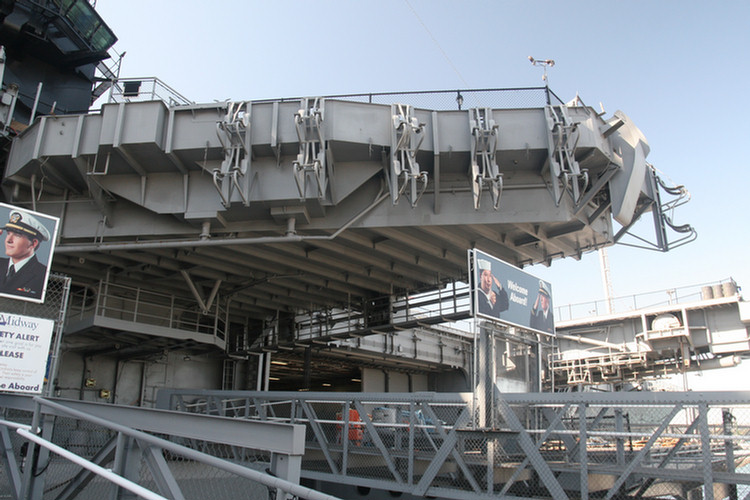

Training Planes On The Hangar Deck


Did you know? - On 2 August 1990, Iraq invaded a neighbor Kuwait, and U.S. forces moved into Saudi Arabia as part of Operation Desert Shield to protect that country against invasion by Iraq. On 1 November 1990, Midway was again on station in the North Arabian Sea, relieving Independence. On 15 November, she participated in Operation Imminent Thunder, an eight-day combined amphibious landing exercise in northeastern Saudi Arabia which involved about 1,000 U.S. Marines, 16 warships, and more than 1,100 aircraft. Meanwhile, the United Nations set an ultimatum deadline of 15 January 1991 for Iraq to withdraw from Kuwait.
Operation Desert Storm began the next day, and the Navy launched 228 sorties from Midway and Ranger (CV-61) in the Persian Gulf, from Theodore Roosevelt (CVN-71) en route to the Gulf, and from John F. Kennedy, Saratoga, and America in the Red Sea. In addition, the Navy launched more than 100 Tomahawk missiles from nine ships in the Mediterranean Sea, the Red Sea, and the Persian Gulf. Desert Storm officially ended 27 February, and Midway departed the Persian Gulf 11 March 1991 and returned to Yokosuka.
Into The Labyrinth We Go!


The ships store sold everything from gum to Rolex watches!

Enlisted men's bunks... 3,500 of them around the ship!
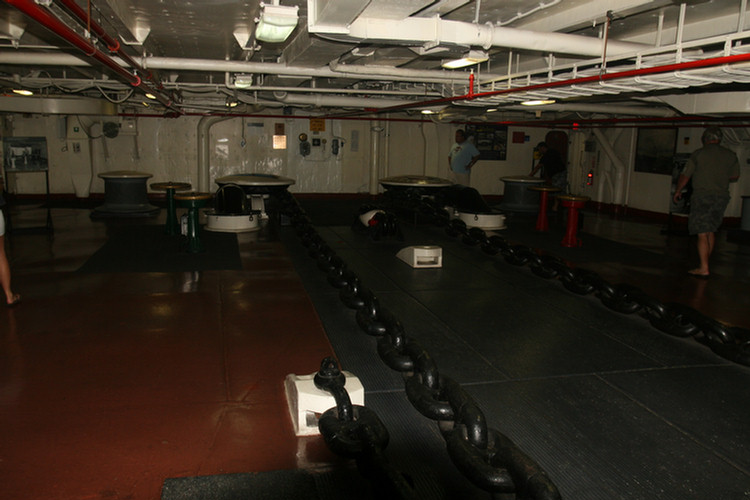
The chain is 1,000 feet long, 130 pounds/link! Holds a 40,000 pound anchor
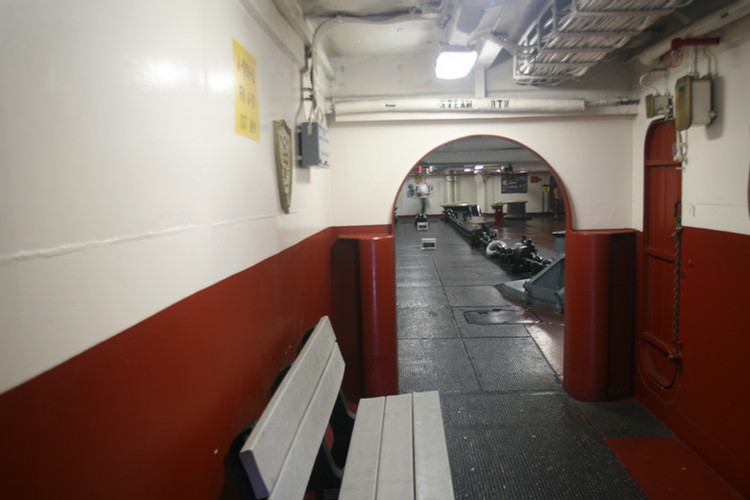
The anchor room
Did you know? - An anchor works by resisting the movement force of the vessel which is attached to it. There are two primary ways to do this—via sheer mass, and by "hooking" into the seabed. While permanent moorings can use large masses resting on this seabed this is not practical for temporary anchors which need to be stowed onboard so almost all temporary anchors are of the type which have metal flukes which hook on to rocks in the bottom or bury themselves in soft bottoms.
An interesting element of anchor jargon is the term aweigh, which describes the anchor when it is hanging on the rope, not resting on the bottom; this is linked to the term to weigh anchor, meaning to lift the anchor from the sea bed, allowing the ship or boat to move. An anchor is described as aweigh when it has been broken out of the bottom and is being hauled up to be stowed. Aweigh should not be confused with under way, which describes a vessel which is not moored to a dock or anchored, whether or not it is moving through the water. Thus, a vessel can be under way (or underway) with no way on (i.e., not moving)

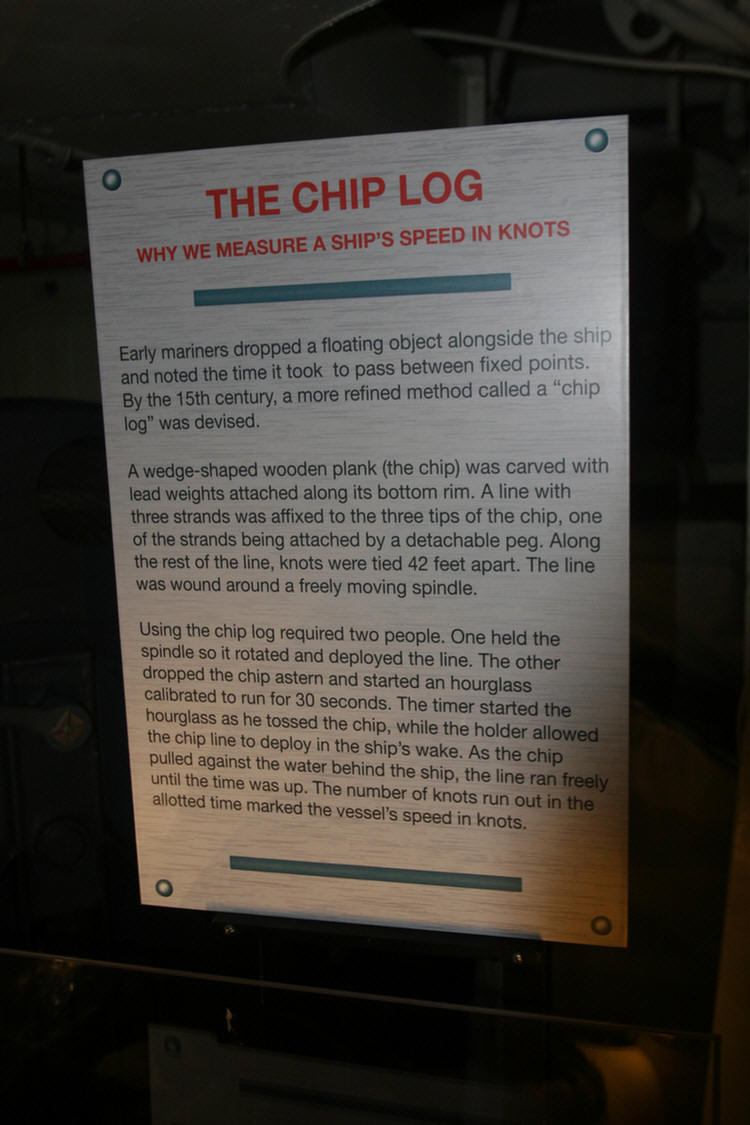
Now we know about knots!
Did you know? - A chip log consists of a wooden board attached to a line (the log-line). The log-line has a number of knots tied in it at uniform spacings. The log-line is wound on a reel to allow it to be paid out easily in use.Over time, the log was standardized in construction. The shape is a quarter circle, or quadrant and the log-line is attached to the board with a bridle of three lines connected to the vertex and to the two ends of the quadrant's arc. In order to ensure that the log submerges and is oriented correctly, the bottom of the log is weighted with lead. This provides for more resistance in the water and a more accurate and repeatable reading of speed. The bridle is attached in such a way that a strong tug on the log-line results in one or two of the bridle's lines releasing, allowing the log to be retrieved with relative ease

We managed to trip through every doorway!
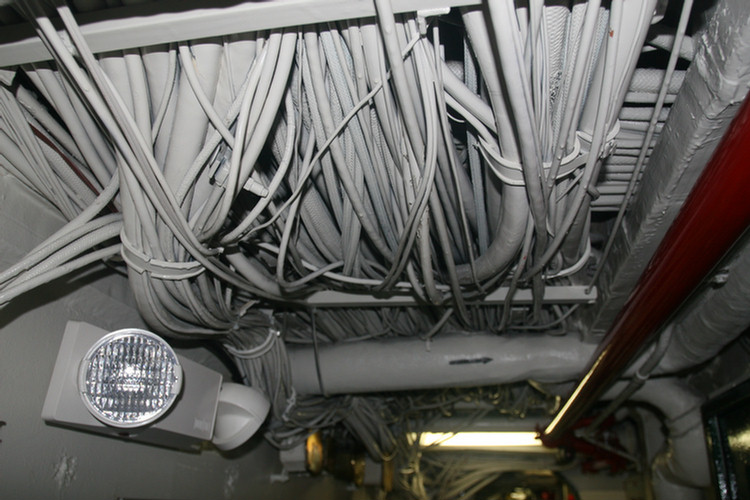
The miles of cables in the overheads was astounding!
It's A Carrier Therefore We Need Ready-Rooms
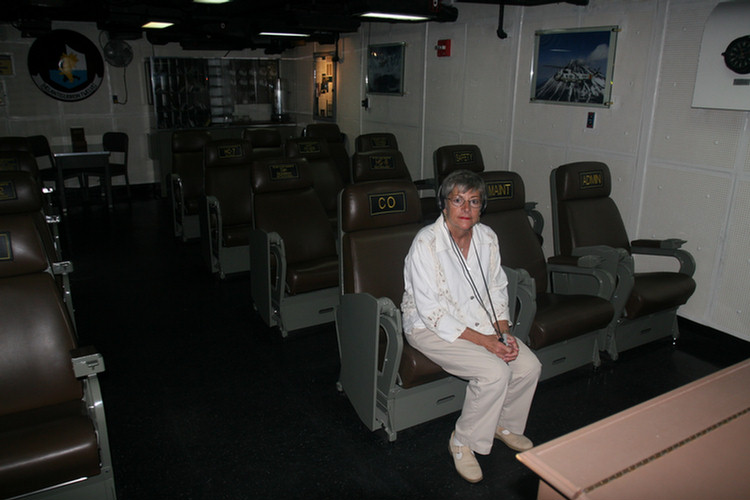

Did you know? - A ready room is a room on a aircraft carrier where on-duty pilots "stand by" their aeroplanes. Each flight squadron has its own individual ready room. Large squadrons, such as torpedo and dive-bomber squadrons, can have more than one ready room. Most ready rooms are located between the flight and hangar decks, but some are located on the flight deck.

The Journey Continues

The audio headphones were fantastic!


You step out a door and volia, you are in the hangar bay again!

JT97 Jet Engine

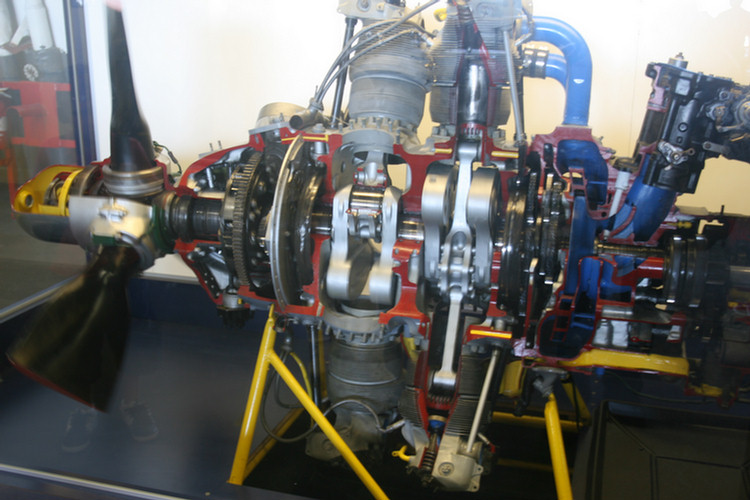
The engine that won the war in the Pacific!
Did you know? - The radial engine is a reciprocating type internal combustion engine configuration in which the cylinders point outward from a central crankshaft like the spokes on a wheel. This configuration was very commonly used in large aircraft engines before most large aircraft started using turbine engines. Radial engines of 100 to 165 hp were popular during the 1930s, before the introduction of modern-type opposed-cylinder engines.

In a radial engine the pistons are connected to the crankshaft with a master-and-articulating-rod assembly. One piston has a master rod with a direct attachment to the crankshaft. The remaining pistons pin their connecting rods attachments to rings around the edge of the master rod (see animation). Four-stroke radials always have an odd number of cylinders per row, so that a consistent every-other-piston firing order can be maintained, providing smooth operation. Most radial engines use overhead poppet valves driven by pushrods and lifters on a cam plate which is concentric with the crankshaft. A few engines utilize sleeve valves instead.
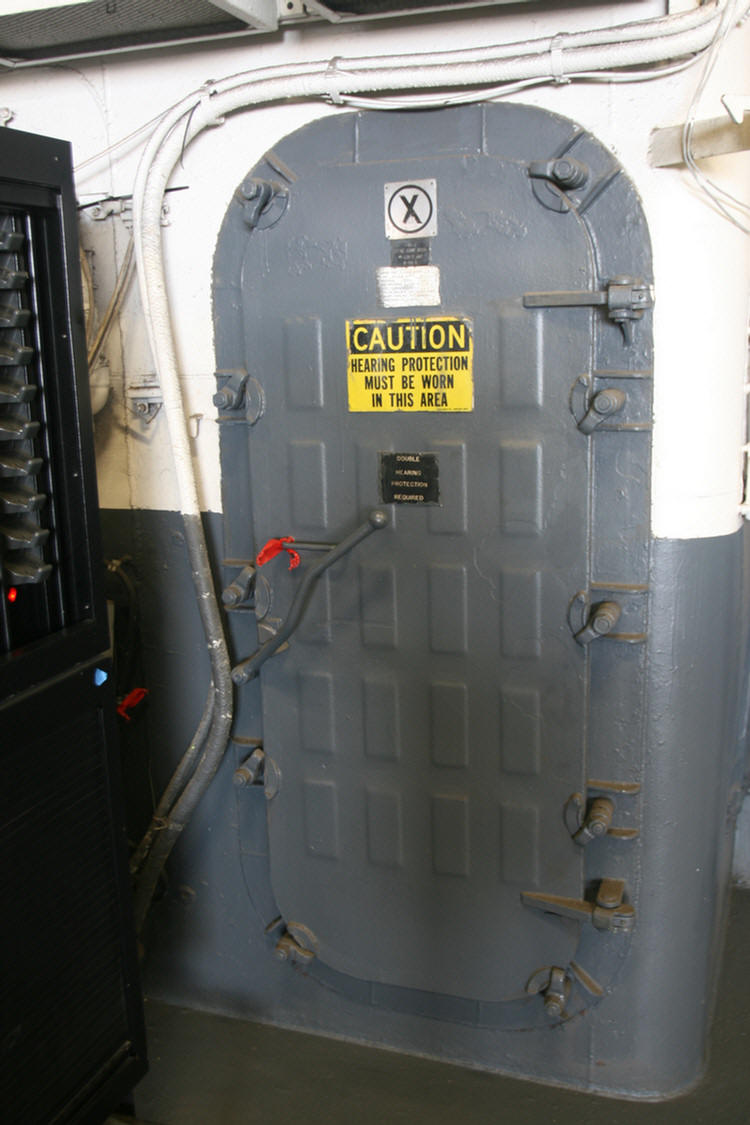
Heavy machinery everywhere!

Making liquid oxygen for the pilots to use! Dangerous business
Did you know? - Liquid oxygen (also LOx, LOX or Lox in the aerospace, submarine and gas industry) is a form of the element oxygen. It has a pale blue color and is strongly paramagnetic. Liquid oxygen has a density of 1.141 g/cm³ (1.141 kg/L) and is cryogenic (freezing point: 50.5 K (−222.65 °C), boiling point: 90.19 K (−297.33 °F, −182.96 °C) at 101.325 kPa (760 mmHg). In commerce, liquid oxygen is classified as an industrial gas and is widely used for industrial and medical purposes. Liquid oxygen is obtained from the oxygen found naturally in air by fractional distillation. Liquid oxygen has an expansion ratio of 861:1 at 68 °F (20 °C); and because of this, it is used in some commercial and military aircraft as a source of breathing oxygen.
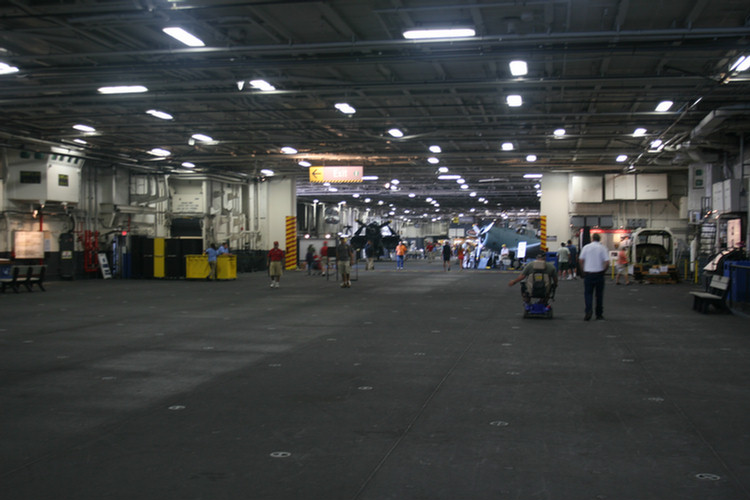
The hangar deck is huge!

She is walking on glass... She is five stories about he ship's magazine!
Did you know? - Magazine is the name for an item or place within which ammunition is stored. It is taken from the Arabic word "makahazin" meaning "warehouse". 'Magazine' was also often used for a place where ammunition for weapons that can be carried by a single combatant is stored. This small-arms ammunition storage is kept under careful control due to the potential for theft and misuse. The weapons themselves are kept in a separate armory for safety and improved security.
Historically, when artillery was powered by gunpowder, a vessel's magazine would be kept below water level. The gunner and his mates would wear felt slippers, or go barefoot, to prevent sparks. The door to the magazine would be a felt curtain, kept wet. Light would be provided through a window, from an adjacent room. A naked flame was never allowed inside the magazine.
More modern warships use semi-automated or automated ammunition hoists. The path through which the cannons' ammunition passed typically has blast-resistant airlocks and other safety devices, including provisions to flood the compartment with seawater in an emergency.
The separation of shell and charge gave the storage of the former the name "shell room" and the latter "powder room".

A natural look?

Heading Toward The Engine Room
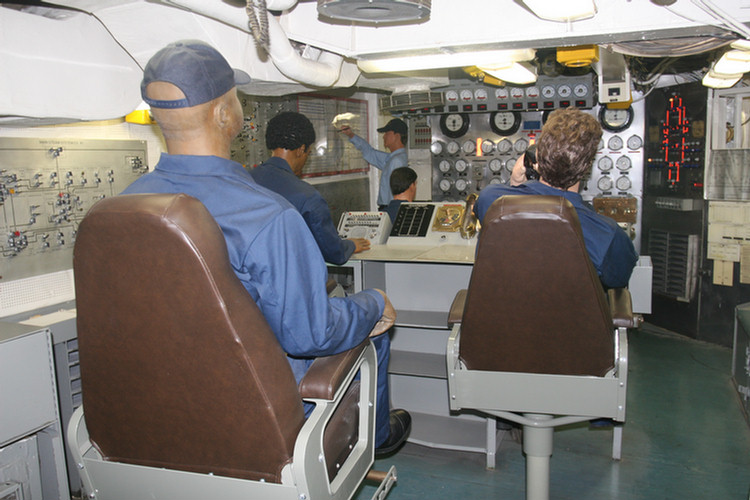
The Ships engines are commanded from here
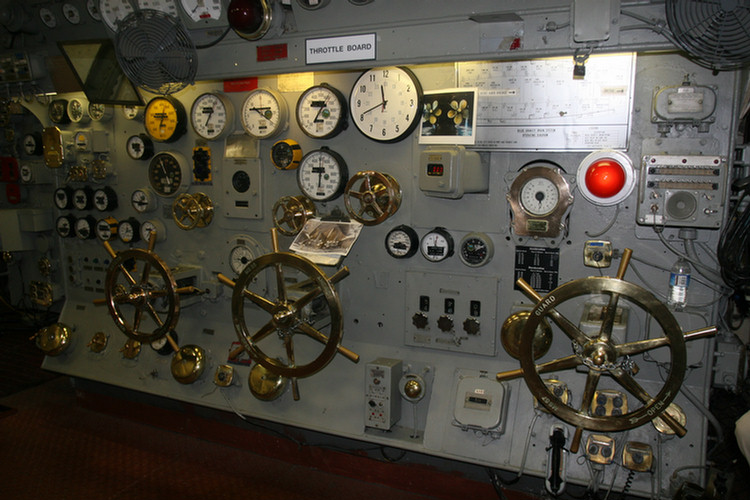
One of four engine throttle board... Note the bells on the bottom of the board
Did you know? - An engine order telegraph or E.O.T., often also chadburn, is a communications device used on a ship or submarine for the pilot on the bridge to order engineers in the engine room to power the vessel at a certain desired speed. In early vessels, from the 1800s until about 1950, the device usually consisted of a round dial about nine inches (~20 centimetres) in diameter with a knob at the center attached to one or more handles, and an indicator pointer on the face of the dial. Modern E.O.T.s on vessels which still use them use electronic light and sound signals.
Traditional engine order telegraph
Traditional E.O.T.s required a pilot wanting to change speed to "ring" the telegraph on the bridge, moving the handle to a different position on the dial. This would ring a bell in the engine room and move their pointer to the position on the dial selected by the bridge. The engineers hear the bell and move their handle to the same position to signal their acknowledgment of the order, and adjust the engine speed accordingly. Such an order is called a "bell," for example the order for a ship's maximum speed, flank speed, is called a "flank bell."
For urgent orders requiring rapid acceleration, the handle is moved three times so that the engine room bell is rung three times. This is called a "cavitate bell" because the rapid acceleration of the ship's propeller will cause the water around it to cavitate, causing a lot of noise and wear on the propellers. Such noise is undesirable during conflicts because it can give away a vessel's position.

The engines are just below the waterline...
Did you know? - The waterline is an imaginary line marking the level at which a ship or boat floats in the water. To an observer on the ship the water appears to rise or fall against the hull . Temperature also affects the level because warm water provides less buoyancy, being less dense than cold water. Likewise the salinity of the water affects the level, fresh water being less dense than salty seawater.
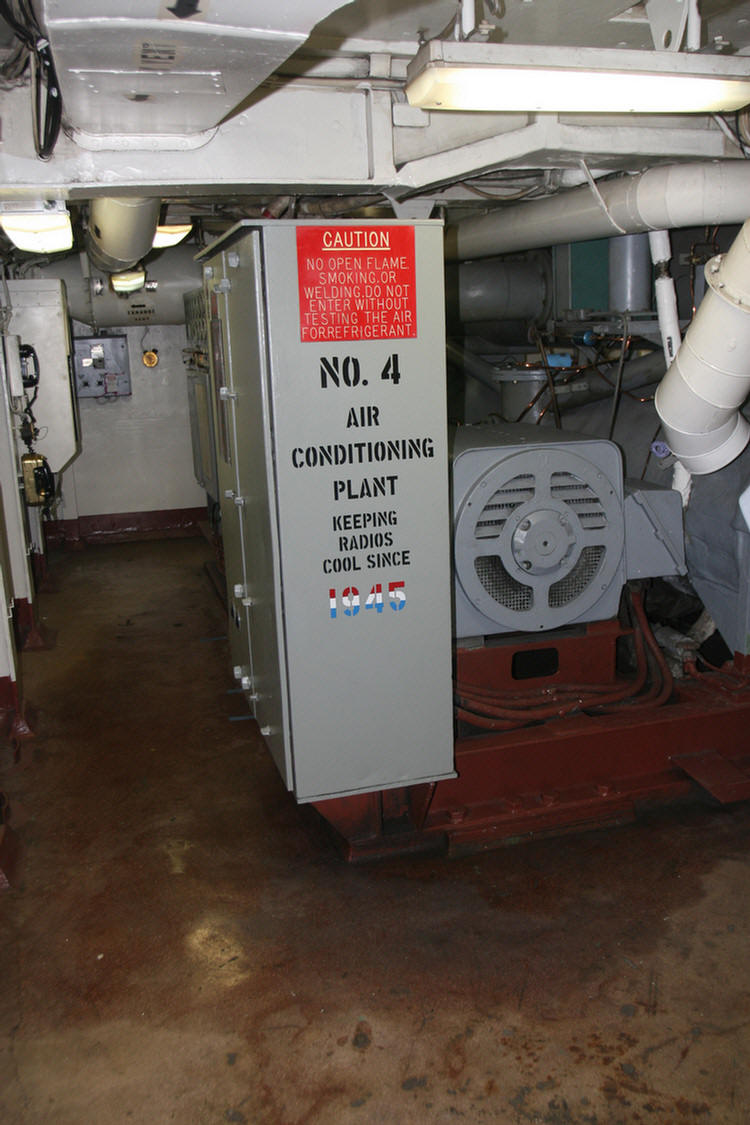
Just for the electronics... Not the people!

Great displays.. Steam powers everything including the laundry room!

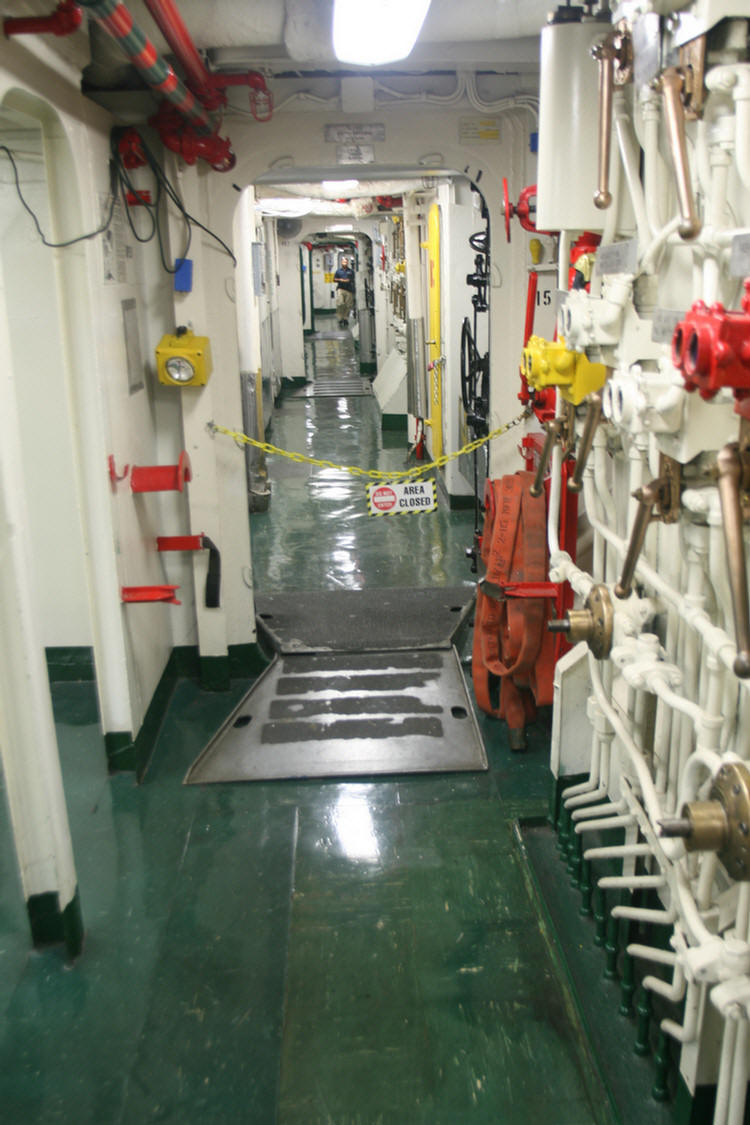
Getting lost is Childs play!
Up From The Engine Room Back Onto The Hangar Deck

This type airplane sank four Japanese carriers at Midway!

No Sue... This is NOT how we leave the ship!

Off we go into the wild blue yonder
Downstairs Again To The Galley, Chapel And Other Areas

Four meals a day to 3,600 people

Serving all faiths

Pumps everywhere... Even outside the Captains quarters

XO's home away from home

Senior officers dining room

Junior officers mess
Did you know? - A mess is the place where military personnel socialize, eat, and (in some cases) live. In some societies this military usage has extended to other disciplined services eateries such as civilian fire fighting and police forces. The root of "mess" is the Old French "mes," portion of food, drawn from the Latin verb "mittere," meaning "to send" or "to put," the original sense being "a course of a meal put on the table." This sense of "mess," which appeared in English in the 13th century, was often used for cooked or liquid dishes in particular, as in the "mess of pottage" (porridge or soup) for which Esau in Genesis traded his birthright. By the 15th century, a group of people who ate together was also known as a "mess," and it is this sense that persists in the "mess halls" of today's military.
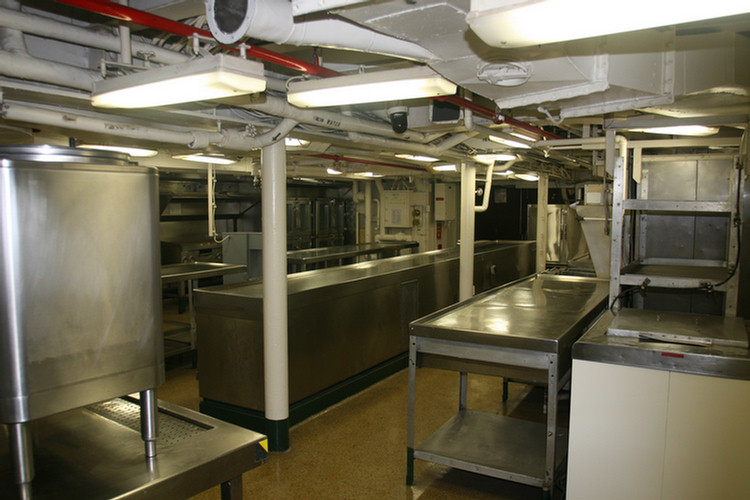
The kitchens were amazing to see
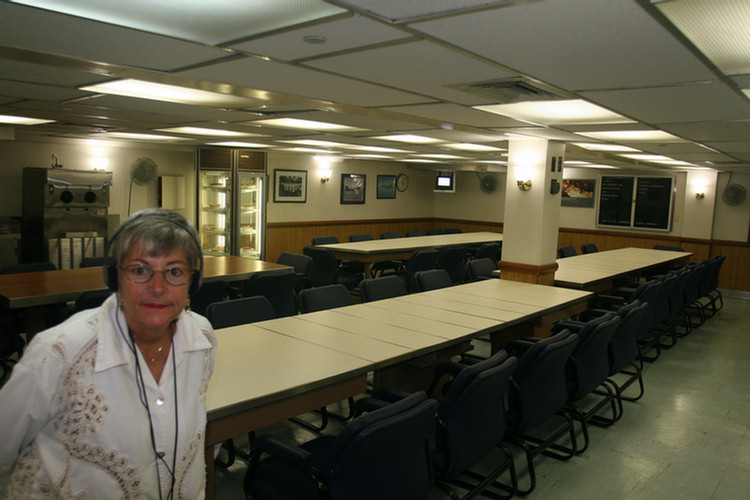
Officers mess

Always plenty of food!
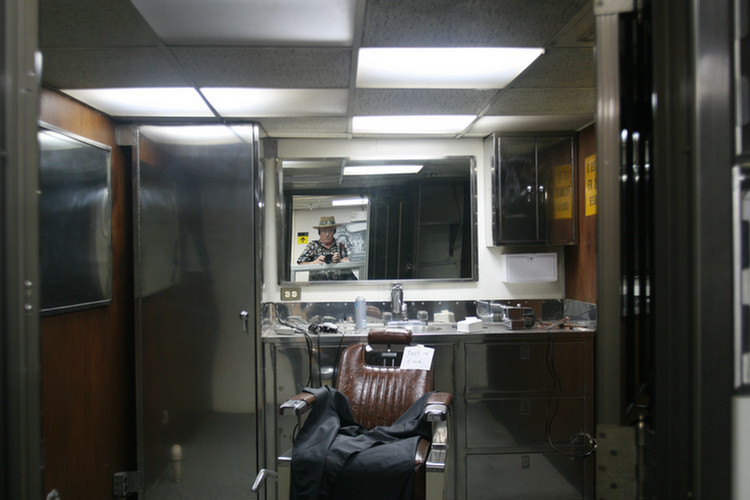
Officer's barbershop
The Laundry Did 1,000,000 Pounds A Year! Working 24x7!
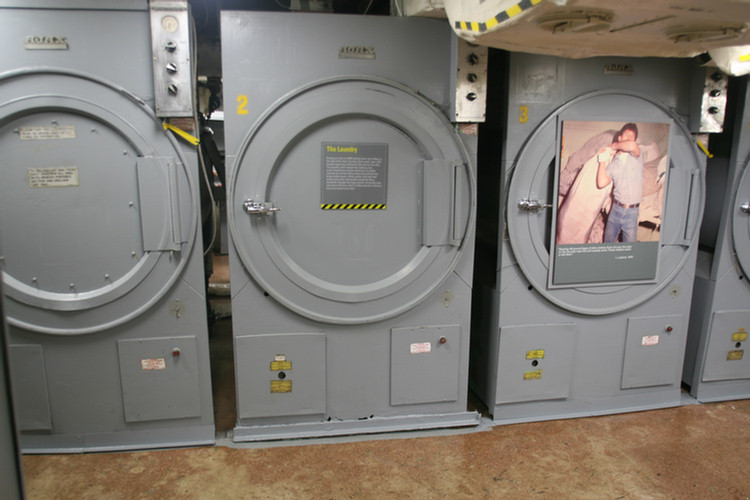
Steam from the ships boilers are used to wash clothes

The presses are directly above the ships propellers

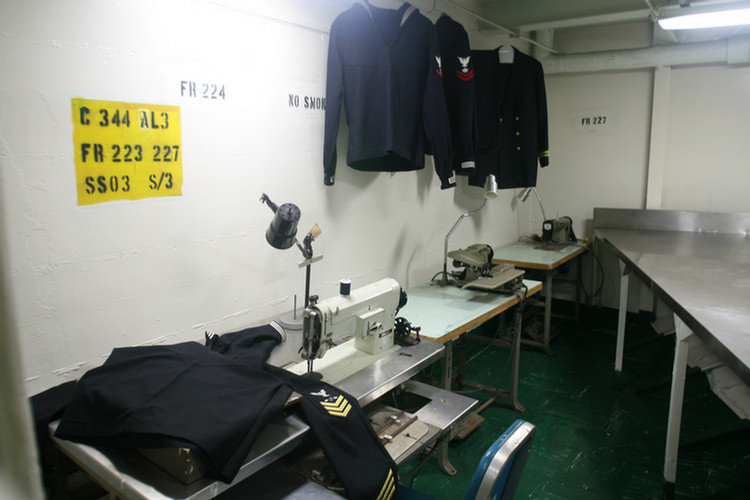
Clothes repair
Main Galley Served 14,000 Meals Per Day!

A wall of convection ovens

60 gallon soup preparation stations

You take 40 pounds of peas, 100 pounds of chicken, 23 gallons of.....

Valves everywhere

The ships magazine is three floors under the galley.. Sue was two floor up earlier
The Chief's Mess... Best In The Fleet

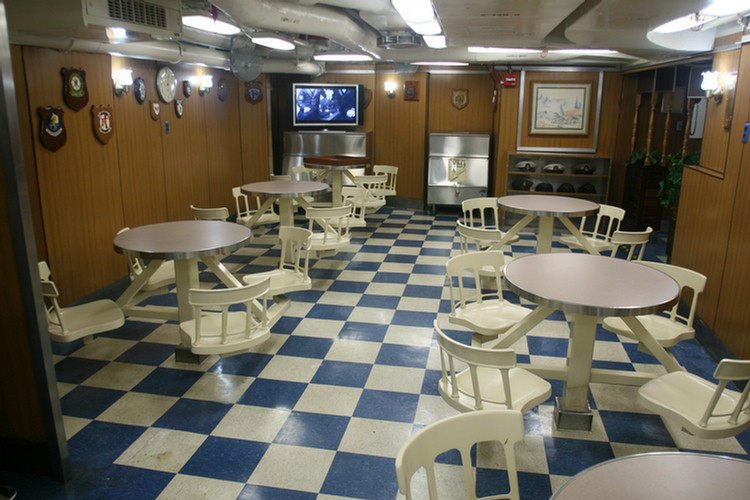
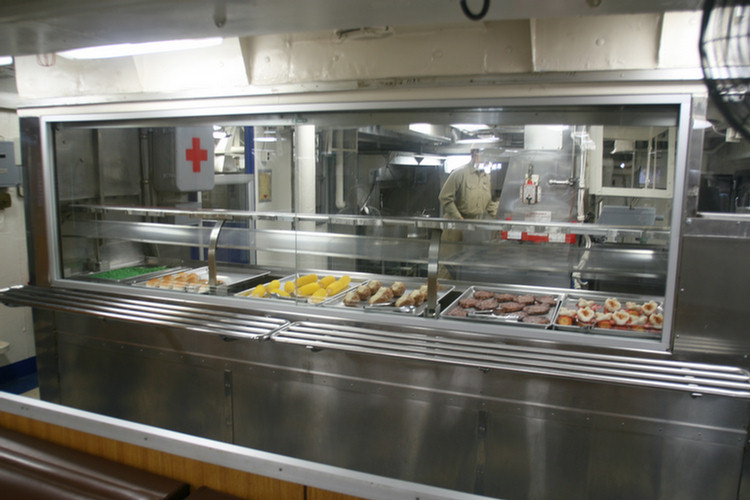

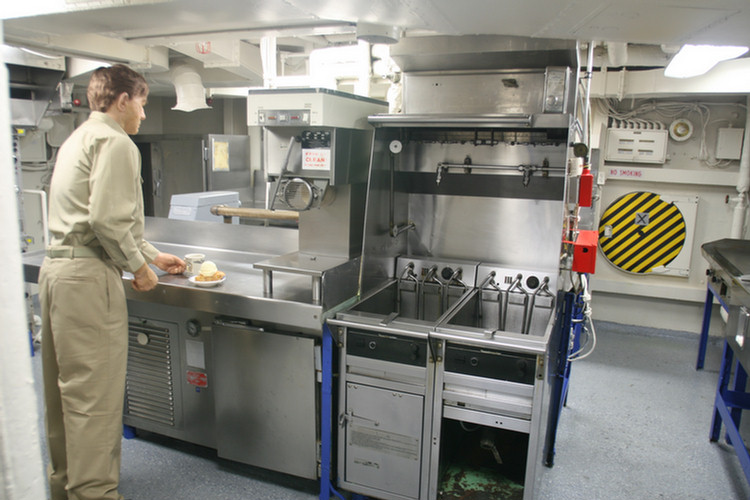
The Chief's had their own galley

Ships Hospital Was Quite Complete

Two operating rooms
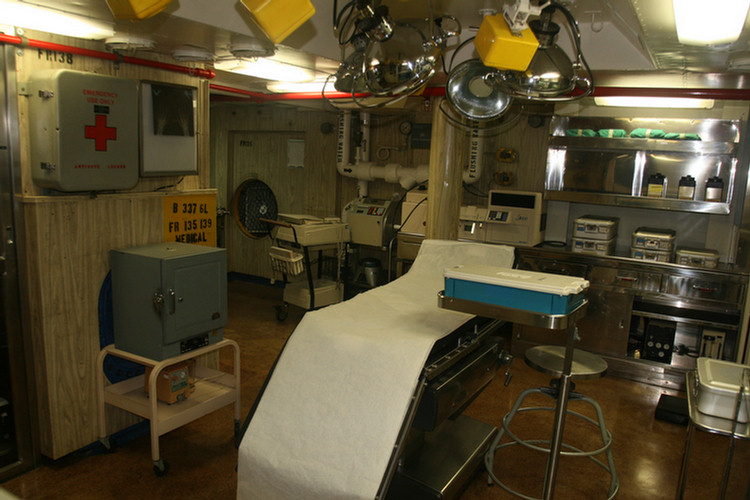
Several exam rooms
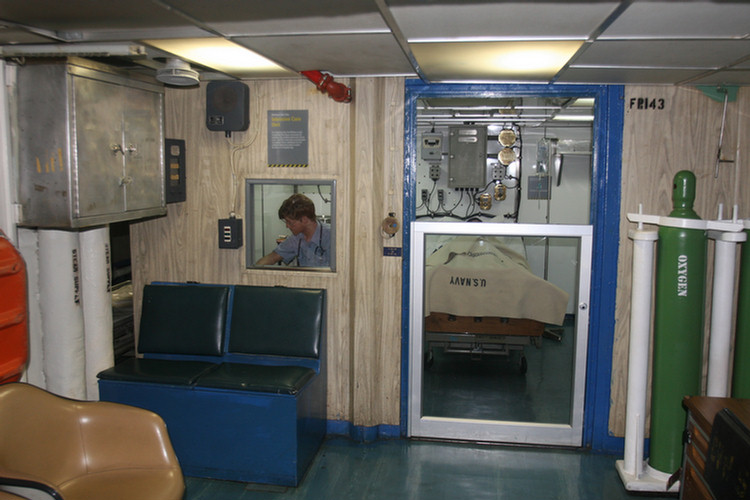
Intensive care unit
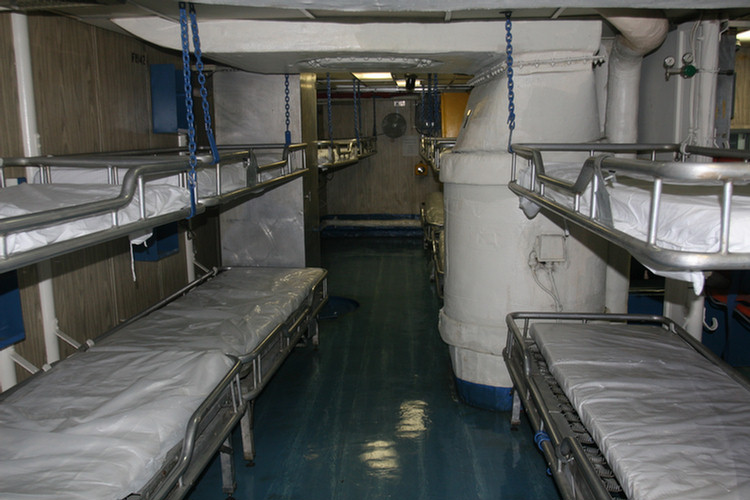
Hospital beds

One of the main dining areas... public off-duty areas

The post master scared everybody to death!!

Machine shops made everything from paper clips to helicopter movers
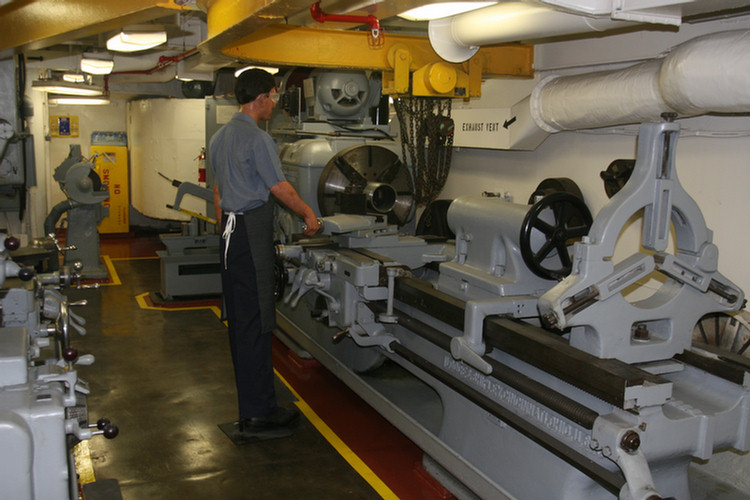
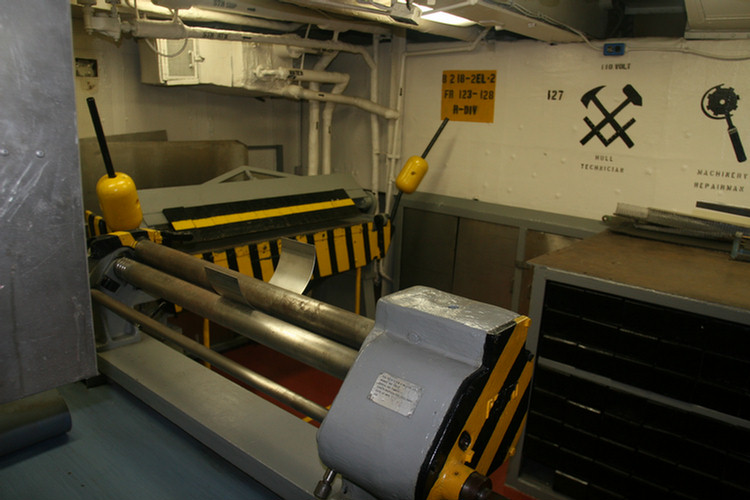
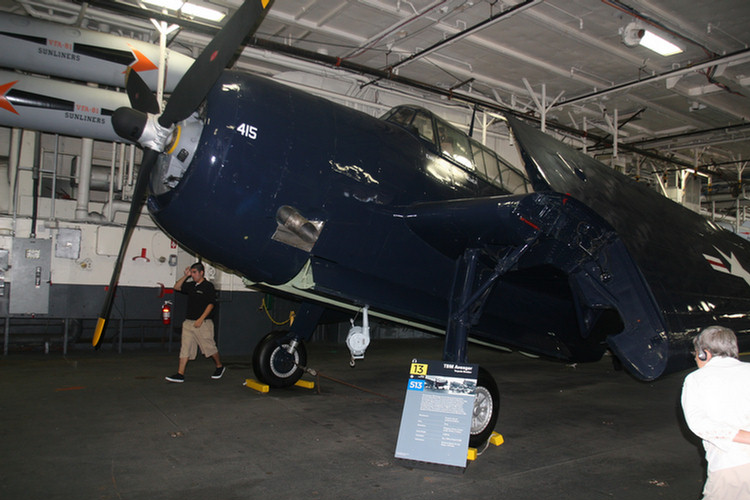
Back on the hangar deck and time to eat
Did you know? - The flight deck of an aircraft carrier is the surface from which its aircraft take off and land, essentially a miniature airfield at sea. On smaller naval ships which do not have aviation as a primary mission, the landing area for helicopters and other VTOL aircraft is also referred to as the flight deck. The official U.S. Navy term for these vessels is "aviation capable ships"
